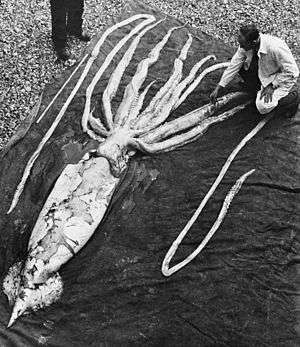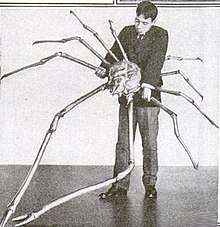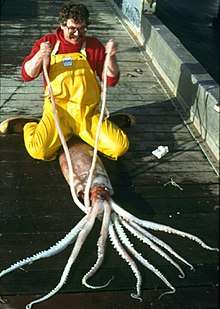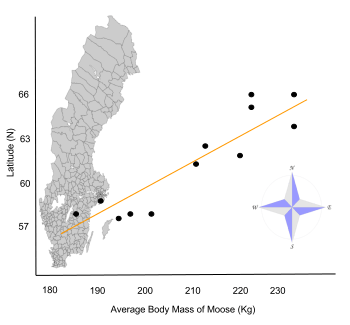Deep-sea gigantism

In zoology, deep-sea gigantism, also known as abyssal gigantism, is the tendency for species of invertebrates and other deep-sea dwelling animals to be larger than their shallower-water relatives. Proposed explanations involve adaptation to scarcer food resources, greater pressure or colder temperature at depth.
Taxonomic range
| “ | Other [animals] attain under them gigantic proportions. It is especially certain crustacea which exhibit this latter peculiarity, but not all crustacea, for the crayfish like forms in the deep sea are of ordinary size. I have already referred to a gigantic Pycnogonid [sea spider] dredged by us. Mr. Agassiz dredged a gigantic Isopod eleven inches in length. We also dredged a gigantic Ostracod. For over 125 years, scientists have contemplated the extreme size of Bathynomus giganteus. – Henry Nottidge Moseley, 1880[1] | ” |
Examples of deep-sea gigantism include the giant isopod,[1] giant ostracod,[1] the giant sea spider,[1] the giant amphipod, the Japanese spider crab, the giant oarfish, the deepwater stingray, the seven-arm octopus,[2] and a number of squid species: the colossal squid (up to 14 m in length),[3] the giant squid (up to 12 m),[3] Onykia robusta, Taningia danae, Galiteuthis phyllura, Kondakovia longimana, and the bigfin squid.
Explanations
In the case of marine crustaceans, it has been proposed that the increase in size with depth occurs for the same reasons as the increase in size with latitude (Bergmann's rule): both trends involve increasing size with decreasing temperature.[4] The trend with depth has been observed in mysids, euphausiids, decapods, isopods, and amphipods.[4] The trend with latitude has been observed in some of the same groups, both in comparisons of related species as well as within widely distributed species.[4] Decreasing temperature is thought to result in increased cell size and increased life span, both of which lead to an increase in maximum body size (continued growth throughout life is characteristic of crustaceans).[4] In Arctic and Antarctic seas where there is a reduced vertical temperature gradient, there is also a reduced trend towards increased body size with depth, arguing against hydrostatic pressure being an important factor.[4]
Temperature does not appear to have a similar role in influencing the size of giant tube worms. Riftia pachyptila, which lives in hydrothermal vent communities at ambient temperatures of 2–30 °C,[5] reaches lengths of 2.7 m, comparable to those of Lamellibrachia luymesi, which lives in cold seeps. The former, however, has rapid growth rates and short life spans of about 2 years,[6] while the latter is slow growing and may live over 250 years.[7]
Gallery
See also
References
- 1 2 3 4 McClain, Craig. "Why isn't the Giant Isopod larger?". Deep Sea News. Retrieved 1 March 2018.
- ↑ Hoving, H. J. T.; Haddock, S. H. D. (2017-03-27). "The giant deep-sea octopus Haliphron atlanticus forages on gelatinous fauna". Scientific Reports. 7: 44952. doi:10.1038/srep44952.
- 1 2 Anderton, Jim (22 February 2007). "Amazing specimen of world's largest squid in NZ". New Zealand Government. Archived from the original on 23 May 2010.
- 1 2 3 4 5 Timofeev, S. F. (2001). "Bergmann's Principle and Deep-Water Gigantism in Marine Crustaceans". Biology Bulletin (Russian version, Izvestiya Akademii Nauk, Seriya Biologicheskaya). 28 (6): 646–650 (Russian version, 764–768). doi:10.1023/A:1012336823275.
- ↑ Bright, M.; Lallier, F. H. (2010). "The biology of vestimentiferan tubeworms" (PDF). Oceanography and Marine Biology: An Annual Review. Taylor & Francis. 48: 213–266. doi:10.1201/ebk1439821169-c4. Archived from the original (PDF) on 2013-10-31. Retrieved 2013-10-30.
- ↑ Lutz, R. A.; Shank, T. M.; Fornari, D. J.; Haymon, R. M.; Lilley, M. D.; Von Damm, K. L.; Desbruyeres, D. (1994). "Rapid growth at deep-sea vents". Nature. 371 (6499): 663. doi:10.1038/371663a0.
- ↑ MacDonald, Ian R. (2002). "Stability and Change in Gulf of Mexico Chemosynthetic Communities" (PDF). MMS. Retrieved 2013-10-30.




